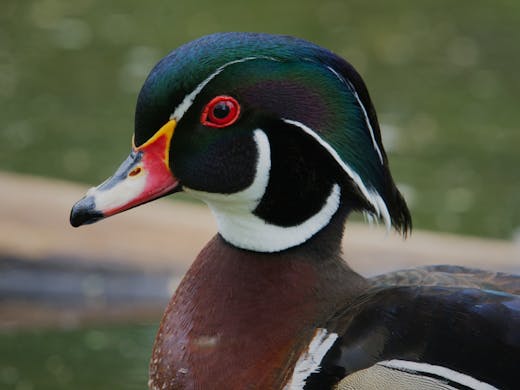Wood Duck Aix sponsa
Mid-sized migratory duck able to perch on trees. Males have colorful feathers and the species used to be hunted for its feathers leading almost to extinction in early 20th Century.
Specs
| Length | 41-51cm |
| Weight | 0.45-0.68kg |
| Wingspan | 66-76cm |
Common Names
| German | Brautente |
| English | Wood Duck |
| French | Canard branchu |
| Spanish | Pato joyuyo |
Taxonomy
| Order | Anseriformes |
| Family | Anatidae |
| Species | Aix sponsa |
Advertisement
We need your help! By making a contribution towards our hosting costs, you can help us provide an ad-free experience on our website in the near future. Paypal
How to Identify
Males colorful feathers around the head are unique and allow identification. Females have a yellow ring around the eyes surrounded by white ring of feathers. Both have a red washed out beak with a black tip.
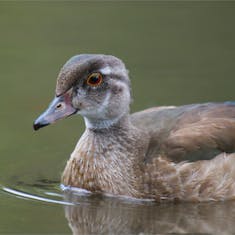
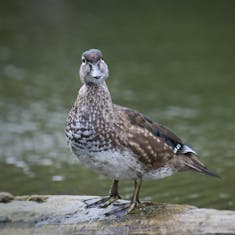
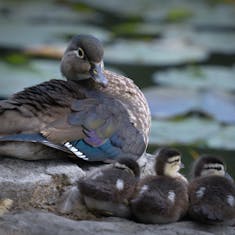
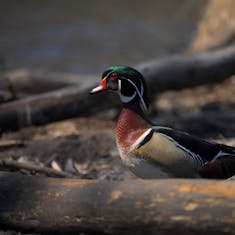
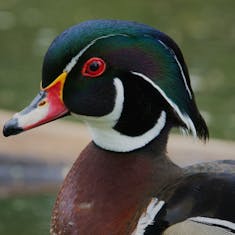

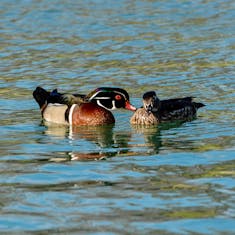
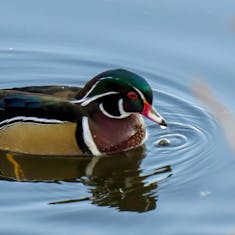
Photography Tips
Parc Bernard-Landry is the best place to photograph this species. Wood Duck (Aix sponsa) can be spotted here during most seasons and in particular during spring. The small pond in the middle of the park allows close up of males and females. There are nesting places in this park but lately, we haven't seen ducklings.
To see, photograph and record ducklings, we suggest visiting Jardin Botanique de Montréal. The ponds are larger than in Parc Bernard-Landry but the chance to see Wood Duck (Aix sponsa) ducklings is higher.
Wood Duck Trivia
Is the Wood Duck related to the Mandarin Duck?
Yes, the Wood Duck and the Mandarin Duck are the only two members of the genus Aix, and they are considered close relatives. They both exhibit colorful plumage and share similar breeding habits.
Does the Wood Duck nest in trees?
Yes, it is one of the few duck species that can perch on branches and utilize tree cavities for nesting. They typically prefer large trees near water, but they will also use nest boxes if available.
Can the Wood Duck chicks fly soon after hatching?
No, its chicks cannot fly until they are about 8-10 weeks old. However, they can jump from their nest to the ground or water when they are only one day old without getting hurt.
Does the Wood Duck have a crest on its head?
Yes, this duck species has a distinctive crest on its head, which is more prominent in males than in females. The crest can be raised or lowered depending on the bird's mood.
Is the Wood Duck a migratory bird?
Yes, this duck species is a migratory bird that travels between its breeding grounds in northern and eastern North America and its wintering grounds in southern and western North America, as well as Central America and the Caribbean.
Does the Wood Duck eat only plants?
No, this duck species is an omnivorous bird that consumes both plants and animals. Its diet includes seeds, nuts, fruits, aquatic plants, insects, snails, worms, and small fish.
Is the Wood Duck native to North America?
Yes, this duck species is native to North America, where it is widely distributed across both eastern and western regions. It is also found in certain parts of Central America and the Caribbean.
Does the Wood Duck have webbed feet?
Yes, this species possesses webbed feet, like most ducks. These webbed feet facilitate swimming and paddling in the water, as well as walking on muddy or slippery surfaces.
Does the Wood Duck have a short bill?
Yes, it has a relatively short bill compared to other ducks. The bill is also narrow and pointed, aiding in picking up seeds and nuts from the water or the ground.
Does the Wood Duck exhibit sexual dimorphism?
Yes, this duck species displays sexual dimorphism, meaning that males and females have different physical appearances. The males exhibit more colorful and patterned plumage than the females, particularly during the breeding season.
Does the Wood Duck produce any sounds?
Yes, this duck species emits various sounds depending on the situation. Males produce high-pitched whistling sounds, while females emit loud quacking sounds. The chicks, on the other hand, emit soft peeping sounds.
Is the Wood Duck a large-sized duck?
No, it is a medium-sized duck, with a body length of approximately 50 cm and a wingspan of about 70 cm. Males are slightly larger than females. On average, the Wood Duck weighs about 500 to 700 grams.
Where and When to Spot
Wood Duck is a migratory bird spending winter in southern areas in the USA. While staying around Montreal, the species can be observed on ponds in forest areas. My favorite spot to watch this bird is Parc de Prairies during Spring.
| Spring | Summer | Fall | Winter | |
|---|---|---|---|---|
| Jardin Botanique de Montréal | x | x | x | - |
| Parc Angrignon | x | x | - | - |
| Parc Bernard-Landry | x | x | x | - |
| Parc Nature Pointe aux Prairies | x | - | - | - |
Where and when a species has been observed, identified, and recorded.
